Axial Compression Behavior of Large-Diameter, Concrete-Filled, Thin-Walled Galvanized Helical Corrugated Steel Tubes Column Embedded with Rebar
Abstract
:1. Introduction
2. Experimental Program
2.1. Test Specimens
2.2. Material Properties
2.3. Test Setup and Instrumentation Layout
3. Experimental Results and Discussion
3.1. Failure Modes
- Initial Loading Stage: The load and deformation of the specimen increased linearly, with no obvious test phenomenon. The corrugations of the CFHCST specimen were closely engaged with the core concrete, and the deformation was coordinated without visible damage.
- Post-Peak Failure Stage: The bearing capacity of the specimen gradually decreased, requiring a longer time and greater vertical deformation to drop to 85% of the peak load. The middle and upper part of the specimen expanded significantly, compressing the corrugations on the outer surface vertically.
- Failure Process: The failure process entailed the expansion of the core concrete under pressure, followed by an increase in the confinement effect of the HCST on the core concrete. This resulted in severe compression at the HCST ends and substantial lateral expansion deformation of the core concrete, ultimately leading to the slipping and tearing of the HCST lock seam (Figure 6c).
- Damage Mode: After peeling off the specimen, it was observed that the HCST and core concrete were tightly interlocked, with no significant slipping in the concrete. The core concrete underwent shear failure almost perpendicular to the helix angle (Figure 6b). The tensile failure test of the lock seam is shown in Figure 7. The lock seam opened by unfolding, indicating that the dents or bites in the crests and troughs observed during the test were not the strength limit of the plate, but rather a local stress release process. The lock seam strength of the HCST was identified as a key factor affecting the axial compression performance of the CFHCST.
3.2. Load–Vertical Strain Curves
3.3. Strength Index and Ductility Index
4. Working Mechanism
4.1. Transverse Deformation Coefficient
4.2. Steel Tube Stress Analysis
4.3. Prediction of Shear Direction of Concrete Core in CST
- (1)
- Bending, tensile, and compressive equivalents perpendicular to the corrugation direction;
- (2)
- Bending, tensile and compressive equivalents along the corrugation direction.
5. Ultimate Load-Bearing Capacity
5.1. Comparison with Design Codes
5.2. Revised Formula for Compressive Capacity
5.2.1. Proposition of Calculation Formula
5.2.2. Verification of Calculation Formula
6. Summary and Conclusions
- (1)
- Lock seam slip and tear failure is a typical failure mode of the HCST. The lock seam strength and helical angle are key factors that affect the axial compression performance and the failure mode of the CFHCST columns. CFHCST columns with a helix angle of 33° exhibit a brittle failure mode with open lock seams, while those with a helix angle not greater than 26° exhibit a better ductile failure mode.
- (2)
- Under an axial compression load, the HCST closely engages with the core concrete, resulting in coordinated deformation. Compared to plain steel tubes, HCSTs provide greater circumferential restraint to the core concrete, and transfer only a portion of the longitudinal stress. This circumferential restraint offered by HCSTs effectively limits the shear deformation of and crack development in the core concrete. Consequently, the failure mode of the composite components becomes more predictable and controllable.
- (3)
- The axial compression load transmission mechanism of the CFHCST composite members: The transmission of longitudinal stress in an HCST is blocked at the crest, resulting in less longitudinal force being borne by the HCST across the entire section. Instead, under the joint action of the “vertical deformation effect” and the “circular tightening effect,” the HCST provides greater circumferential restraint for the core concrete. This circumferential confinement exhibits alternating strong and weak discontinuities along the corrugation direction.
- (4)
- According to the JGJT 471-2019 specifications, a prediction formula for the ultimate load-bearing capacity of CFHCST columns under axial compression is proposed. This formula takes into account the strong restraining effect of HCSTs on the core concrete, as well as the characteristics of HCSTs, such as their corrugated profile and helical angle. The accuracy of this formula is verified using specimens from other researchers. It has been found that this formula provides better predictions for the axial compression ultimate bearing capacity of both steel tube-confined concrete components and CFHCST components.
Author Contributions
Funding
Data Availability Statement
Conflicts of Interest
Nomenclature
| λ | corrugation angle, in ° |
| l | corrugation length, in mm |
| h | corrugation height, in mm |
| Din | inner diameter, in mm |
| Dout | outer diameter, in mm |
| D0 | nominal diameter, in mm |
| t | steel tube thickness, in mm |
| L | short column length, in mm |
| ρb and ρs | volumetric steel ratio of longitudinal and transverse steel bars, in % |
| α | steel ratio of steel tube, in % |
| ξ | confinement index |
| Nu | peak load or ultimate load-bearing capacity, in kN |
| εu | member deformation at peak load, in με |
| SI | strength index |
| DI | ductility index |
| B | width of the strip, in mm |
| ηc | corrugated amplification factor |
| ws | length of one period of corrugation, in mm |
| As and Ac | cross-sectional areas of the steel tube and core concrete, in mm2 |
| fy | average yield strength of the steel tube, in MPa |
| fcp | average prism compressive strength of concrete, in MPa |
| Es and Ec | elastic modulus of steel and concrete, in MPa |
| fy-crest, fy-waist, and fy-trough | yield strengths of crest, waist, and trough, respectively, in MPa |
| λcrest, λwaist, and λtrough | ratios of each position to a complete corrugation |
| Nu | test ultimate axial load, in kN |
| Nuc | nominal ultimate axial load, in kN |
| Δ85% | corresponding displacement when the test ultimate load drops to 85%, in mm |
| Δy | axial yield displacement, in mm |
| U | transverse deformation coefficient |
| εh | hoop strain of the steel tube, in με |
| εv | vertical strain of the steel tube, in με |
| Eθ | equivalent elastic modulus of steel perpendicular to the direction of corrugation, in MPa |
| Ez | equivalent elastic modulus of steel along corrugation direction, in MPa |
| G | shear modulus of steel, in MPa |
| equivalent shear modulus of steel in local coordinates 1–2 and 1–3, in MPa | |
| equivalent shear modulus of steel in local coordinates 2–3, in MPa | |
| fcc | design value of concrete axial compressive strength considering lateral restraint, in MPa |
| fcd | design value of concrete axial compressive strength, in MPa |
| Ab | area of longitudinal steel bars in the composite column, in mm2 |
| Ac | area of concrete in the composite column, in mm2 |
| fyr | yield strength of the longitudinal steel bars in the composite column, in MPa |
| fel | equivalent restraint stress of helical corrugated steel tube, in MPa |
| kc | corrugated factor |
| fyt | yield strength of CST, in MPa |
| A, B, and C | undetermined parameters |
References
- Cao, X.; Xie, X.D.; Zhang, T.Y.; Du, G.F. Bond-slip behavior between high-strength steel tube and Ultra-high Performance Concrete. Structures 2022, 47, 1498–1510. [Google Scholar] [CrossRef]
- Yu, P.; Ren, Z.Y.; Yun, W.J.; Zhao, Y.; Xu, J.L. Performance of Bolt-Welded CFST Short Columns with Different Initial Imperfections: Experimental and Numerical Studies. Buildings 2022, 12, 1352. [Google Scholar] [CrossRef]
- Hassan, M.M.; Mahmoud, A.A.; Serror, M.H. Behavior of concrete-filled double skin steel tube beam-columns. Steel Compos. Struct. 2016, 22, 1141–1162. [Google Scholar] [CrossRef]
- Han, L.H.; Ma, D.Y.; Zhou, K. Concrete-encased CFST structures: Behaviour and application. In Proceedings of the 12th International Conference on Advances in Steel-Concrete Composite Structures (ASCCS), Valencia, Spain, 27–29 June 2018; pp. 1–10. [Google Scholar]
- Zhao, D.; Zhang, J.G.; Lu, L.; Liang, H.Z.; Ma, Z.H. The Strength in Axial Compression of Aluminum Alloy Tube Confined Concrete Columns with a Circular Hollow Section: Experimental Results. Buildings 2022, 12, 699. [Google Scholar] [CrossRef]
- More, F.; Subramanian, S.S. Experimental Investigation on the Axial Compressive Behaviour of Cold-Formed Steel-Concrete Composite Columns Infilled with Various Types of Fibre-Reinforced Concrete. Buildings 2023, 13, 151. [Google Scholar] [CrossRef]
- Liu, B.D.; Zhang, L.L.; Feng, M.Y.; Sun, H.B.; Chai, Y.K. Experimental Study of Rubber-Concrete-Filled CST Composite Column Under Axial Compression. Int. J. Steel Struct. 2023, 23, 247–262. [Google Scholar] [CrossRef]
- Wang, Y.Y.; Yang, L.G.; Yang, H.; Liu, C.Y. Behaviour of concrete-filled corrugated steel tubes under axial compression. Eng. Struct. 2019, 183, 475–495. [Google Scholar] [CrossRef]
- Tang, Z.J.; Hong, S.K.; Xiao, W.Z.; Taylor, J. Characteristics of iron corrosion scales established under blending of ground, surface, and saline waters and their impacts on iron release in the pipe distribution system. Corros. Sci. 2006, 48, 322–342. [Google Scholar] [CrossRef]
- Chen, T.L.; Su, M.Z.; Pan, C.L.; Zhang, L.; Wang, H.M. Local buckling of corrugated steel plates in buried structures. Thin-Walled Struct. 2019, 144, 11. [Google Scholar] [CrossRef]
- Biddah, A.; Ghobarah, A.; Aziz, T.S. Upgrading of nonductile reinforced concrete frame connections. J. Struct. Eng. ASCE 1997, 123, 1001–1010. [Google Scholar] [CrossRef]
- Ghobarah, A.; Biddah, A.; Mahgoub, M. Rehabilitation of reinforced concrete columns using corrugated steel jacketing. J. Earthq. Eng. 1997, 1, 651–673. [Google Scholar] [CrossRef]
- Liu, B.D.; Zhang, L.L.; Sun, H.B.; Feng, M.Y.; Dou, K.J. Side shear strength and load-transfer mechanism of corrugated steel column-foundation socket connection. Case Stud. Constr. Mater. 2022, 17, 22. [Google Scholar] [CrossRef]
- Su, R.; Li, X.; Zhong, T.; Zhou, T. Axial behavior of novel CFDST columns with outer welded corrugated steel tubes. Structures 2021, 34, 2708–2720. [Google Scholar] [CrossRef]
- Fang, Y.; Liu, C.Y.; Yang, H.; Yang, L.G. Axial behaviour of concrete-filled corrugated steel tubular column embedded with structural steel. J. Constr. Steel Res. 2020, 170, 29. [Google Scholar] [CrossRef]
- Yang, L.G.; Wang, Y.Y.; Elchalakani, M.; Fang, Y. Experimental behavior of concrete-filled corrugated steel tubular short columns under eccentric compression and non-uniform confinement. Eng. Struct. 2020, 220, 22. [Google Scholar] [CrossRef]
- Fang, Y.; Wang, Y.; Yang, H.; Lin, X. Experimental behavior of concrete-filled thin-walled corrugated steel tubes with large helical angles under monotonic and cyclic axial compression. Thin-Walled Struct. 2022, 173, 109043. [Google Scholar] [CrossRef]
- Xiao, X.H.; Bu, G.B.; Ou, Z.H.; Li, Z.C. Nonlinear in-plane instability of the confined FGP arches with nanocomposites reinforcement under radially-directed uniform pressure. Eng. Struct. 2022, 252, 12. [Google Scholar] [CrossRef]
- Xiao, X.H.; Zhang, Q.; Zheng, J.X.; Li, Z.C. Analytical model for the nonlinear buckling responses of the confined polyhedral FGP-GPLs lining subjected to crown point loading. Eng. Struct. 2023, 282, 13. [Google Scholar] [CrossRef]
- Li, Z.C.; Zhang, Q.; Shen, H.; Xiao, X.H.; Kuai, H.D.; Zheng, J.X. Buckling performance of the encased functionally graded porous composite liner with polyhedral shapes reinforced by graphene platelets under external pressure. Thin-Walled Struct. 2023, 183, 11. [Google Scholar] [CrossRef]
- Zhang, Q.; Li, Z.C.; Huang, H.; Zhang, H.P.; Zheng, H.; Kuai, H.D. Stability of submarine bi-material pipeline-liner system with novel polyhedral composites subjected to thermal and mechanical loading fields. Mar. Struct. 2023, 90, 12. [Google Scholar] [CrossRef]
- Chang, G.; Zhang, Q.; Li, Y.; Li, Z. Analytical and numerical buckling of bi-material pipelines reinforced by novel composite polyhedral linings. Appl. Ocean. Res. 2023, 141, 103799. [Google Scholar] [CrossRef]
- Fang, Y.; Wang, Y.; Hou, C.; Lu, B. CFDST stub columns with galvanized corrugated steel tubes: Concept and axial behaviour. Thin-Walled Struct. 2020, 157, 107116. [Google Scholar] [CrossRef]
- Fang, Y.; Wang, Y.Y.; Zhang, B.; Dong, J.C. Behaviour of concrete-filled thin-walled corrugated steel tubes under cyclic axial compression. Thin-Walled Struct. 2021, 162, 24. [Google Scholar] [CrossRef]
- Han, L.H.; Zhao, X.L.; Tao, Z. Tests and mechanics model for concrete-filled SHS stub columns, columns and beam-columns. Steel Compos. Struct. 2001, 1, 51–74. [Google Scholar] [CrossRef]
- GB. 50010-2010; Code for Design of Concrete Structures. Standards Press of China: Beijing, China, 2010.
- GB/T 34567-2017; Cold-Formed Corrugated Steel Pipes. China Standard Press: Beijing, China, 2017.
- GB/T 228-2010; Metallic Materials-Tensile Testing—Part 1: Method of Test at Room Temperature. Standards Press of China: Beijing, China, 2010.
- GB/T 50081-2002; Standard for Test Method of Mechanical Properties on Ordinary Concrete. China Architecture and Building Press: Beijing, China, 2002.
- G.B. 1499.2-2018; Steel for the Reinforcement of Concrete—Part 2: Hot Rolled Ribbed Bars. Standards Press of China: Beijing, China, 2010.
- Wang, Y.Y.; Chen, J.; Geng, Y. Testing and analysis of axially loaded normal-strength recycled aggregate concrete filled steel tubular stub columns. Eng. Struct. 2015, 86, 192–212. [Google Scholar] [CrossRef]
- Yang, Y.F.; Han, L.H. Compressive and flexural behaviour of recycled aggregate concrete filled steel tubes (RACFST) under short-term loadings. Steel Compos. Struct. 2006, 6, 257–284. [Google Scholar] [CrossRef]
- Feng, M.Y.; Liu, B.D.; Zhang, L.L.; Wang, Y.Y.; Sun, H.B. Seismic behavior of embedded rubberized concrete-filled corrugated steel tube column-to-foundation connections: Experimental, numerical modelling, and design. Soil Dyn. Earthq. Eng. 2024, 176, 16. [Google Scholar] [CrossRef]
- Park, R. Evaluation of ductility of structures and structural assemblages from laboratory testing. Bull. N. Z. Soc. Earthq. Eng. 1989, 22, 155–166. [Google Scholar] [CrossRef]
- Zhou, M.; Xu, L.Y.; Tao, M.X.; Fan, J.S.; Hajjar, J.F.; Nie, J.G. Experimental study on confining-strengthening, confining-stiffening, and fractal cracking of circular concrete filled steel tubes under axial tension. Eng. Struct. 2017, 133, 186–199. [Google Scholar] [CrossRef]
- Uenaka, K. Concrete filled double skin square tubular stub columns subjected to compression load. Struct. Eng. Mech. 2021, 77, 745–751. [Google Scholar] [CrossRef]
- Ha, N.S.; Lu, G.X. Thin-walled corrugated structures: A review of crashworthiness designs and energy absorption characteristics. Thin-Walled Struct. 2020, 157, 40. [Google Scholar] [CrossRef]
- Dayyani, I.; Shaw, A.D.; Flores, E.L.S.; Friswell, M.I. The mechanics of composite corrugated structures: A review with applications in morphing aircraft. Compos. Struct. 2015, 133, 358–380. [Google Scholar] [CrossRef]
- Yokozeki, T.; Takeda, S.; Ogasawara, T.; Ishikawa, T. Mechanical properties of corrugated composites for candidate materials of flexible wing structures. Compos. Pt. A-Appl. Sci. Manuf. 2006, 37, 1578–1586. [Google Scholar] [CrossRef]
- Elshimi, T.M. Three-Dimensional Nonlinear Analysis of Deep-Corrugated Steel Culverts. Ph.D. Thesis, Queen’s University, Kingston, ON, Canada, 2011. [Google Scholar]
- JGJT 471-2019; Technical Standard for Steel Tube Confined Concrete Structures. China Standard Press: Beijing, China, 2019.
- GB50936-2014; Technical Code for Concrete Filled Steel Tubular Structure. China Standard Press: Beijing, China, 2014.
- Eurocode 4; Design of Composite Steel and Concrete Structure: Part 1-1: General Rules for Buildings. European Committee for Standardization: Brussels, Belgium, 2004.
- Chai, Y. Experimental Study on Mechanical Properties of Short Corrugated Steel Tube Filled with Rubberized Concrete under Axial Load; Beijing Jiaotong University: Beijing, China, 2019. [Google Scholar]
- Du, F.Z.; Pan, S.S.; Li, D.S. Damage evaluation and failure mechanism analysis of steel tube confined reinforced-concrete columns by acoustic emission technology. Lat. Am. J. Solids Struct. 2018, 15, 14. [Google Scholar] [CrossRef]
- Liu, J.P.; Zhang, S.M.; Zhang, X.D.; Guo, L.H. Behavior and strength of circular tube confined reinforced-concrete (CTRC) columns. J. Constr. Steel Res. 2009, 65, 1447–1458. [Google Scholar] [CrossRef]
- Zhou, X.; Yan, B.; Liu, J. Axial load behavior of circular tubed reinforced concrete columns with different length-to-diameter ratios. J. Build. Struct. 2018, 39, 11–21. [Google Scholar]



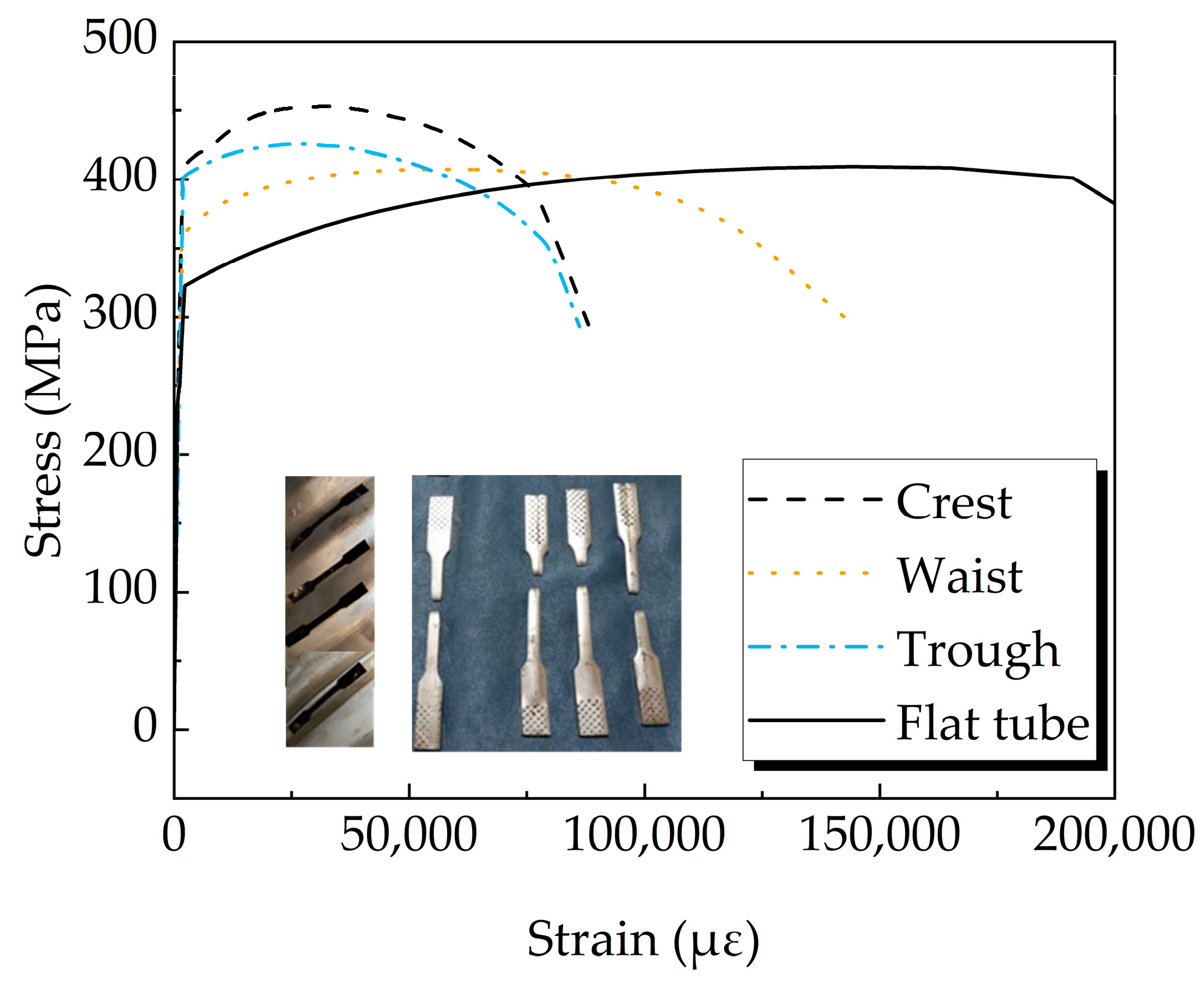
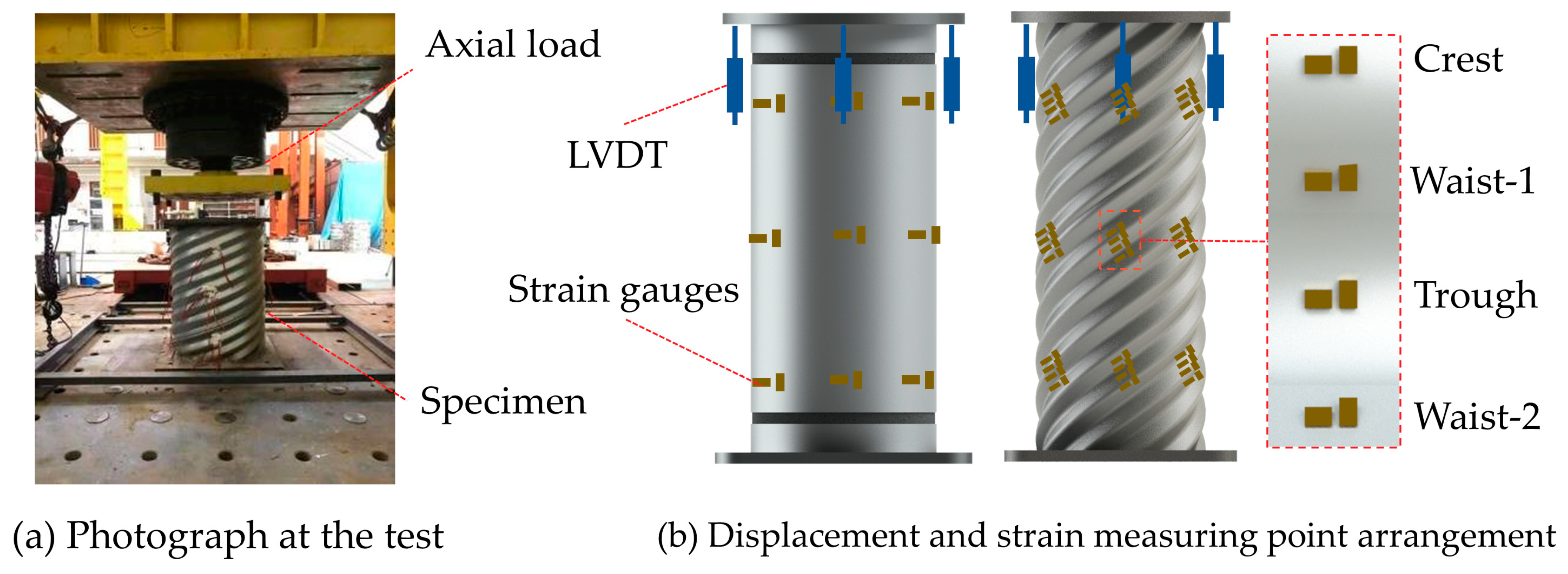

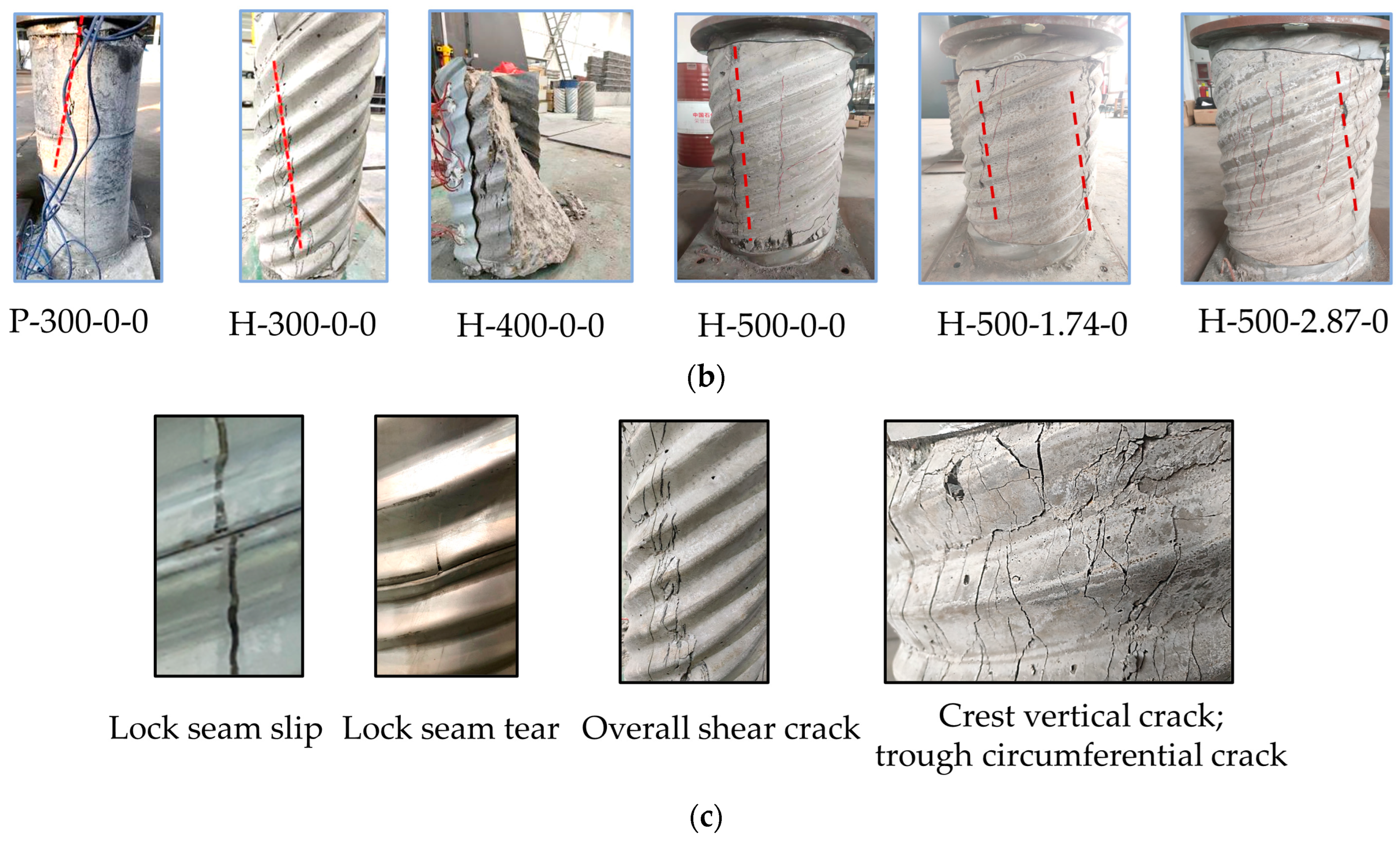
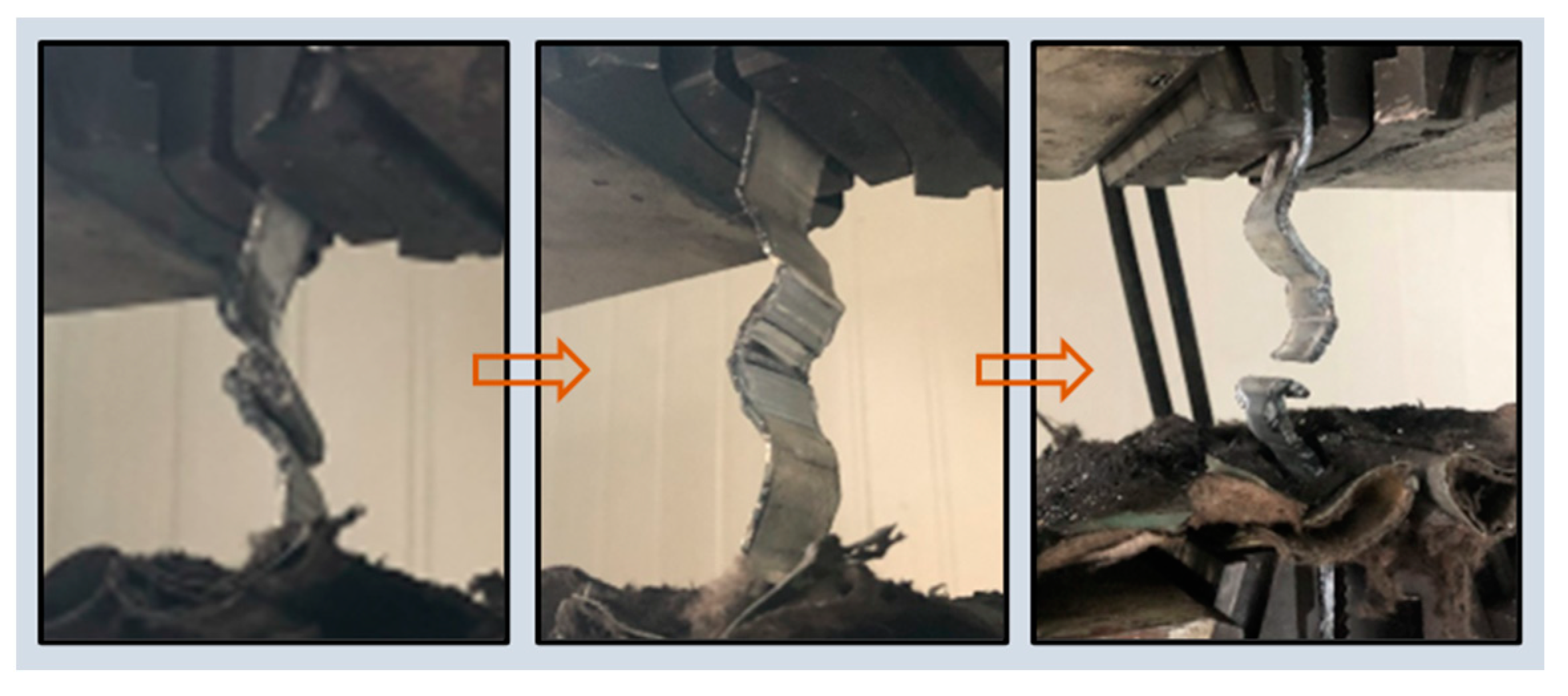



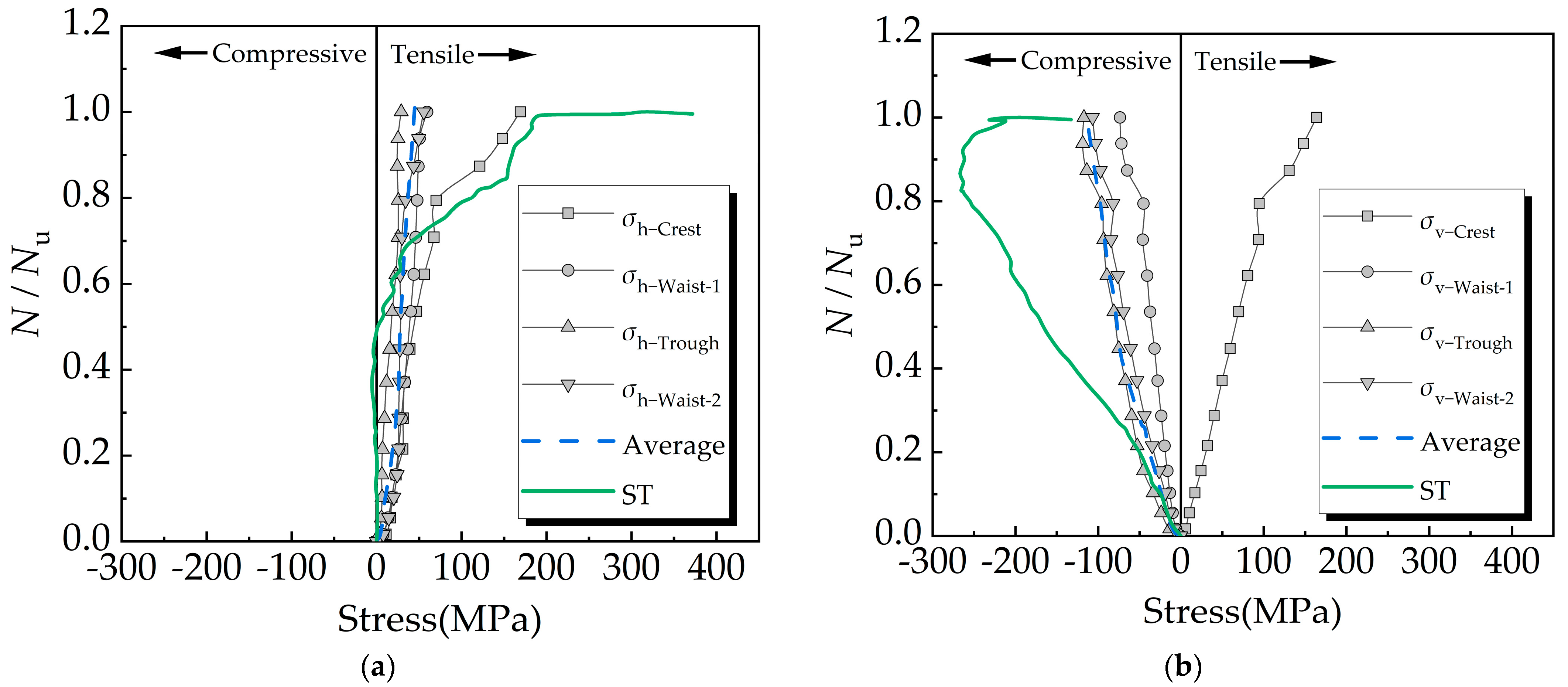
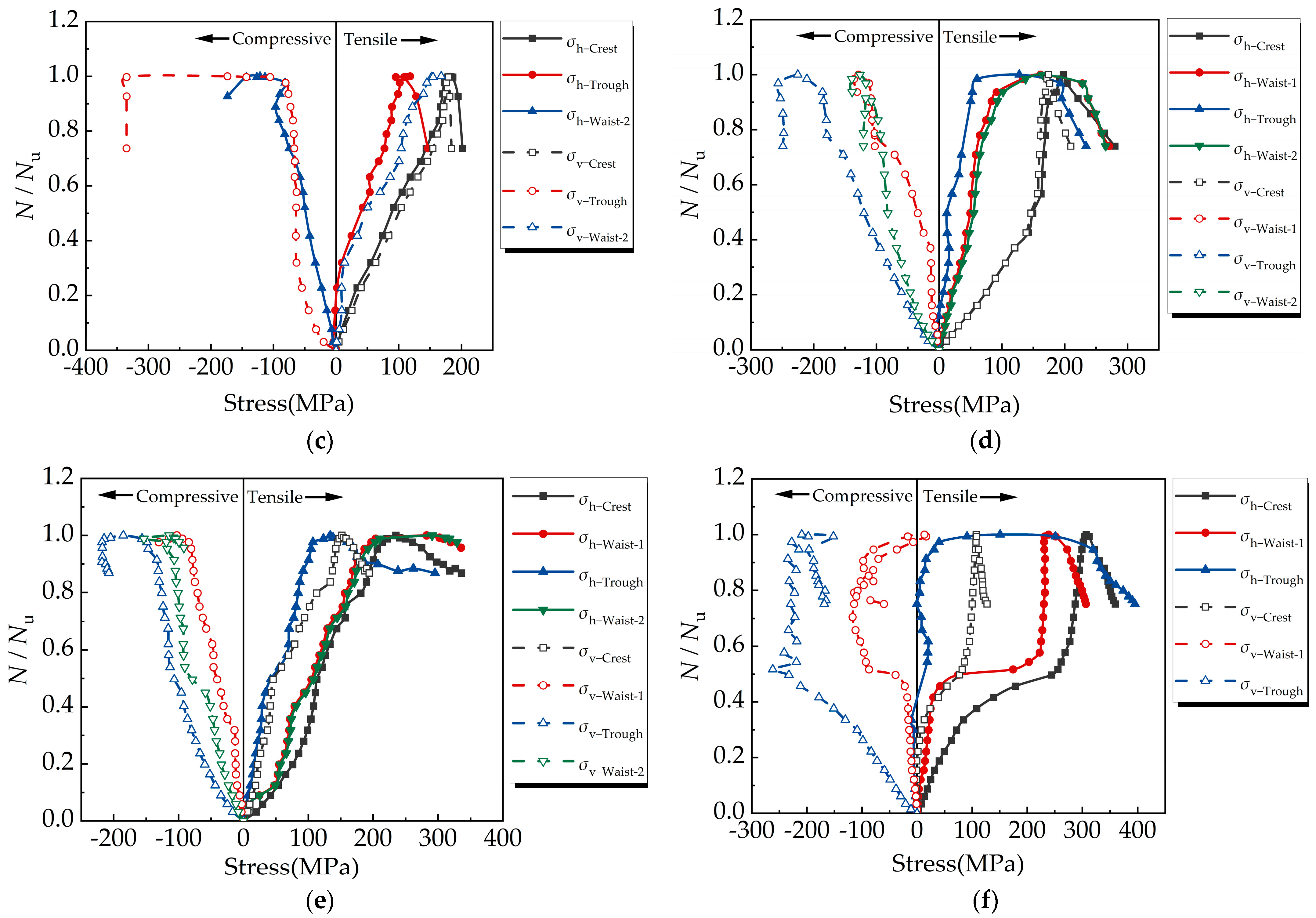


| Specimens | Tubular Type | λ (°) | l × h | D0 | t | L | ρb (%) | ρs (%) | α (%) | ξ | Nu | εu | SI | DI |
|---|---|---|---|---|---|---|---|---|---|---|---|---|---|---|
| (mm) | (kN) | (με) | ||||||||||||
| P-300-0-1 | PST | / | / | 327 | 2.0 | 750 | 0 | 0 | 2.477 | 0.195 | 3983 | 5826 | 1.13 | 1.60 |
| H-300-0-0 | HCST | 33 | 68 × 13 | 315 | 2.0 | 750 | 0 | 0 | 2.663 | 0.162 | 4738 | 3927 | 1.06 | / |
| H-400-0-0 | 26 | 68 × 13 | 415 | 2.0 | 750 | 0 | 0 | 2.036 | 0.124 | 7640 | 5012 | 1.02 | 1.11 | |
| H-500-0-0 | 21 | 68 × 13 | 515 | 2.0 | 750 | 0 | 0 | 1.648 | 0.100 | 12,700 | 5796 | 1.12 | 1.78 | |
| H-500-1.74-0 | 21 | 68 × 13 | 515 | 2.0 | 750 | 1.74 | 0.09 | 1.648 | 0.100 | 12,900 | 6206 | 1.03 | 4.20 | |
| H-500-2.87-0 | 21 | 68 × 13 | 515 | 2.0 | 750 | 2.87 | 0.09 | 1.648 | 0.100 | 14,900 | 6839 | 1.11 | 2.68 | |
 | ||||||||||||||
| Type | Code | fcp (MPa) | Ec (MPa) | Thickness or Diameter (mm) | fy (MPa) | Es (MPa) |
|---|---|---|---|---|---|---|
| Concrete | C40 | 44.7 | 33,700 | / | / | / |
| HCST | Crest | / | / | 2.019 | 419.9 | 205,000 |
| Waist | / | / | 2.083 | 348.1 | ||
| Trough | / | / | 2.105 | 405.3 | ||
| Lock seam | / | / | 2.019 | 407.6 | ||
| Rebar | Φ6 | / | / | 6 | 402.3 | 205,000 |
| Φ16 | / | / | 16 | 396.2 |
| Specimens | Nu (kN) | NJGJT (kN) | NJGJT/Nu | NGB (kN) | NGB/Nu | NEC-4 (kN) | NEC-4/Nu |
|---|---|---|---|---|---|---|---|
| P-300-0-1 | 3983 | 4456 | 1.119 | 3990 | 1.001 | 4125 | 1.035 |
| H-300-0-0 | 4110 | 5023 | 1.222 | 4487 | 1.091 | 4578 | 1.113 |
| H-400-0-0 | 7640 | 8075 | 1.057 | 6815 | 0.892 | 7488 | 0.980 |
| H-500-0-0 | 12,700 | 11,829 | 0.931 | 9761 | 0.768 | 11,100 | 0.874 |
| H-500-1.74-0 | 12,900 | 12,957 | 1.004 | 10,089 | 0.844 | 12,228 | 0.947 |
| H-500-2.87-0 | 14,900 | 13,687 | 0.918 | 11,619 | 0.779 | 12,957 | 0.869 |
| Mean | 1.042 | 0.896 | 0.970 | ||||
| Standard deviation | 0.106 | 0.117 | 0.086 |
Disclaimer/Publisher’s Note: The statements, opinions and data contained in all publications are solely those of the individual author(s) and contributor(s) and not of MDPI and/or the editor(s). MDPI and/or the editor(s) disclaim responsibility for any injury to people or property resulting from any ideas, methods, instructions or products referred to in the content. |
© 2023 by the authors. Licensee MDPI, Basel, Switzerland. This article is an open access article distributed under the terms and conditions of the Creative Commons Attribution (CC BY) license (https://creativecommons.org/licenses/by/4.0/).
Share and Cite
Sun, H.; Zhang, L.; Liu, Y.; Liu, B.; Feng, M. Axial Compression Behavior of Large-Diameter, Concrete-Filled, Thin-Walled Galvanized Helical Corrugated Steel Tubes Column Embedded with Rebar. Buildings 2024, 14, 24. https://doi.org/10.3390/buildings14010024
Sun H, Zhang L, Liu Y, Liu B, Feng M. Axial Compression Behavior of Large-Diameter, Concrete-Filled, Thin-Walled Galvanized Helical Corrugated Steel Tubes Column Embedded with Rebar. Buildings. 2024; 14(1):24. https://doi.org/10.3390/buildings14010024
Chicago/Turabian StyleSun, Haibo, Linlin Zhang, Yu Liu, Baodong Liu, and Mingyang Feng. 2024. "Axial Compression Behavior of Large-Diameter, Concrete-Filled, Thin-Walled Galvanized Helical Corrugated Steel Tubes Column Embedded with Rebar" Buildings 14, no. 1: 24. https://doi.org/10.3390/buildings14010024






